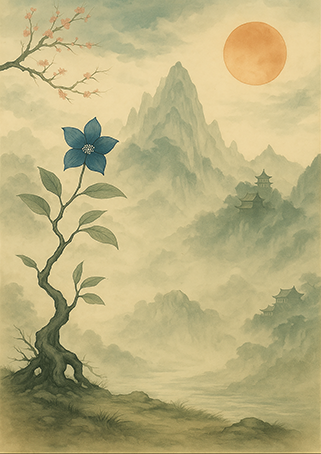Xieyi・The Rootless Tree:100 Verses-Verse 2#502

The poems of “The Rootless Tree” express a fundamental force rooted in harmony with heaven and earth, the cyclical flow of yin and yang, and the infinite potential of existence。
This painting is an expressive “Xieyi” in the tradition of “futu” (spiritual diagrams), passed down for generations in Wudang Mountain, China. It is drawn through a technique where energy flow (xingqi) channels the internal intention into visual form。 In the Taoist world, there exist spiritual and symbolic images called “futu”。
In the Taoist world, there exist spiritual and symbolic images called “futu”。
These are a type of talisman—not merely religious items, but expressive spiritual paintings that act directly on the mind of the viewer。
Since ancient times, many people have placed these Taoist-style “Xieyi” and futu in their homes, studies, or bedrooms, wishing for longevity, health, auspiciousness, and family harmony. Viewing such paintings was not just aesthetic appreciation, but an act of inviting the presence of the Dao into one’s life and tuning the body and mind。
Thus, “Xieyi” is more than artistic expression—it is a medium that bridges the spirit, life, and harmony with the universe。
This kind of artwork is not meant to be seen only with the eyes, but felt with the heart。
It communicates with the Dao, resonates with the qi of nature, and quietly stirs the viewer’s inner self。
Futu and “Xieyi” continue to live on from ancient times to this day as “sacred images that speak to the soul.”
Below, we present the original text of the philosophical poem “The Rootless Tree,” along with a modern Japanese translation and interpretation。
※ The author of “The Rootless Tree,” Zhang Sanfeng (1247–?), is also renowned as the founder of Tai Chi, and it is said that he applied the essence of this work to Tai Chi. As an additional note, we include an interpretation connecting this to the Tai Chi tradition of Wudang Mountain.
The Rootless Tree・Verse 2

▶Original Text
無根樹,花正青,春風秋月長精神。 根深不怕風來倒, 身正何愁霜雪侵。
▶Modern Translation
A blue flower blooms on a rootless tree.
Like the spring wind and the autumn moon, its spirit endures.
If the roots are deep, no gale can topple it;
If the body is upright, frost and snow inspire no fear.
▶Interpretation
1.[無根樹,花正青] – The blue flower signifies quiet vitality and inner strength.
2.[春風秋月長精神] – The spirit lasts as surely as the seasons return.
3.[根深不怕風來倒] – With deep roots, even strong winds cannot fell the tree.
4.[身正何愁霜雪侵] – With an upright body/mind, harsh weather cannot harm you.
▶Interpretation related to Tai Chi
1.Inner growth matters more than outward form.
2.Train over long seasons rather than chase quick results.
3.A stable centre of gravity (deep roots) resists external force.
4.Correct posture and aligned mind–body ward off every trial.
Supplement
The apparent paradox—“rootless tree” yet “deep roots”—is symbolic.
External supports are absent, yet inward determination supplies the true root, echoing Daoist and Chan ideas of self-reliance and “root in emptiness.”
Copyright © MASAKI WAKABAYASHI. All rights reserved.




